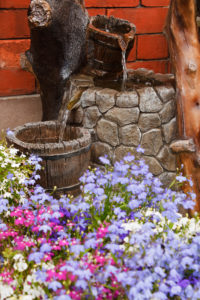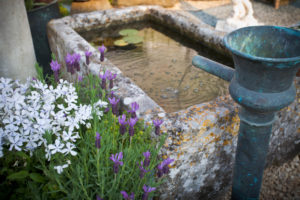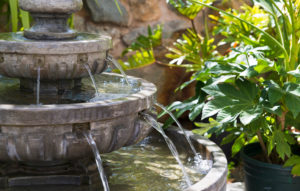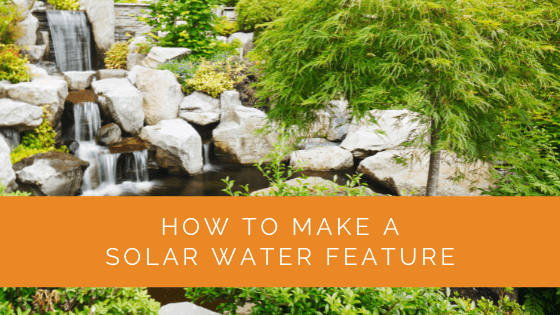The cost of power has been increasing exponentially, and you might look for options to limit your electricity consumption to essential appliances.
Even minor appliances can contribute to an outrageous power bill that might knock your socks off. You’d be surprised to know that a water fountain can consume significant energy, especially if it has a high-end pump. Every time you sit in your yard, you don’t want to remember the electricity being consumed by your water fountain.
Enter—DIY solar water fountains. Not only are they saving power costs for you, but they help you save money! In addition, they can also tackle a variety of other problems. Need to spruce up your backyard but don’t have enough ground?
Tired of the old, monotonous look your garden provides? A solar fountain tackles all of these problems without any second thought. Before we dive into making one at home, let us go back to the roots and understand what a solar panel is.
Contents
- 1 Key Takeaways
- 2 What is a Solar Panel?
- 3 What is a Solar Water Pump?
- 4 Advantages of Using a Solar Pump
- 5 Limitations of Using a Solar Pump
- 6 Pre-Requisites for Setting up A Solar Water Fountain
- 7 Making a Solar Water Surface
- 8 Common Problems
- 9 Is It Worth It?
- 10 Case Study: DIY Solar Water Feature Installation
- 11 Expert Insights From Our Solar Panel Installers About Solar Water Features
- 12 Summing Up
Key Takeaways
- DIY solar water fountains are a cost-effective and eco-friendly alternative to traditional electric water features, saving power costs and reducing environmental impact.
- Setting up a solar water fountain is easy and requires minimal maintenance, making it a practical choice for your garden.
- You’ll need materials like a solar fountain pump, flower pots, an old storage container, garden soil, and flowers to create a basic DIY solar water fountain.
What is a Solar Panel?
A solar panel is a collection of photovoltaic cells to provide a basic idea. These cells help trap sunlight and convert it to direct electrical energy. They are widespread, and you can easily spot them on someone’s rooftop.
Solar panels are generally weighty things mounted professionally, but we will not discuss them in much detail. Instead, we’ll look at their usage in a DIY solar water feature.

What is a Solar Water Pump?
A solar water pump utilises sunlight via a solar panel. It is a device to pump water using solar energy instead of electricity.
The water pump is connected to the solar panel in a typical solar fountain. The solar panel can be separated by a wire or on the fountain. Separating the panel allows you to install the water fountain in the outdoor space. Correspondingly, a solar pump can be used as a stand-alone device to help operate a mechanism.
Advantages of Using a Solar Pump
Solar energy has been around for a while now. Even so, new ways to utilise it are still popping up. a DIY solar water feature boasts of the following.
Easy to Set Up
The only significant requirements for a solar fountain are a sunny location and space. One can install a solar panel easily due to the lack of electrical lines or extension cords.
Low Maintenance
Once set up, the panels only need to be periodically cleaned. The dirt accumulated is less as compared to a conventional electrical motor.
Energy Efficient
It does not make use of electricity in any way or form. Effectively, you can keep your water fountain running for a while at no cost!
Eco-friendly
This one is pretty obvious. Since a solar fountain uses the sun’s energy, it does not aid in trapping greenhouse gases. Moreover, it reduces the load on fossil fuels.
Unique Look
DIY projects offer a way to customise your creations according to your style. A solar water fountain is no different. You can change the attributes according to your preference, and the end product is a unique fountain for your backyard.
Limitations of Using a Solar Pump
Like two sides of the same coin, solar fountains have some limitations we need to address.
High Set-Up Cost
Although it possesses low maintenance, the cost of setting up is higher. Installing a solar panel can take a good chunk out of your pocket!
Specific weather required
You cannot employ the solar panel at nighttime without using battery banks. These need to be purchased separately and drive up the overall cost. Additionally, cloudy days are a mammoth hindrance as well.
Based on the above analysis, the pros of a solar-powered fountain outweigh the cons.
Plus, it doesn’t matter if you’ve never created something by hand. We’ll give you a step-by-step guide and help you create your first DIY project! Don’t worry; it’s super easy and takes only a few hours.
Pre-Requisites for Setting up A Solar Water Fountain
Now that we’ve covered all the details, it’s time to start! Keep in mind that the one we will be designing is a simple fountain with a base for plants. The end product will be a solar fountain doubling as a plant!
Before deciding on one for your garden, let us look at the materials required.

Solar Fountain Pump
The most important part of making a fountain is the pump. The mentioned device can float on water and use solar energy to run the fountain. These are generally available online in excess and at an affordable rate.
Flower Pots
You’ll require two flower pots for this task, one being wider than the other. The wider flower pot will be placed on the ground level, whereas the smaller pot will act as a fountain.
Old Storage Container
You’ll need an old storage container that you can modify. Alternatively, we can also use a 20-litre bucket since the aim is to stack the pots mainly.
Garden Soil and Flowers
Adding flowers is a good idea since the fountain doubles up as a plant. Use flowers that fit your garden and are ideally partial to the sun. The soil needs to be selected carefully and complement the flower.
The materials look pretty basic, don’t they? So, let us begin with the project at hand!
Making a Solar Water Surface
Let us gradually put our accumulated materials to use.
Selecting an Area
Naturally, the very first step involves selecting a place. Keep in mind that it should be an area with adequate sunlight. You can scout your yard for the site that receives the maximum sunlight. On the other hand, this should not interfere with the other plants’ sunlight.
Once you have finalised the spot, whip out the pots, and it’s time to kick off the project!
Creating the Base
As mentioned above, we would require three containers for this task – two pots and a bucket.
Punch small holes in the base of the wider pot and place it on the ground. A hammer and a screw should suffice for this. These holes help enable drainage. By doing this, water flows into the soil.
It’s time for the bucket to be of use now. Grab it and place it upside down inside the wider pot. As a result, there is ample space left inside the wider pot.

Add Soil and Flowers
You can skip this step if you want a simple solar water feature. But if you would like to make it attractive, read on! You can use potting soil and flowers to fill in the gaps in the container on the ground.
Alternatively, you can fill the pot’s side with rocks or fillers.
Creating the Water Fountain
After the base is readied, you can place the small pot on the inverted bucket. Add water to the brim of the top pot with the help of a plastic pail or any medium available.
Now, place the solar water pump in the water. Voila, your DIY solar water feature is ready!
Common Problems
If you need to maintain a higher water level, there’s a trick for that as well!
Ensuring your solar pump is right in the fountain’s centre would be best. Use a cloth hanger or sturdy bamboo sticks attached to the base to bring it to the centre.
Windy days can add to the problem as well. You might find your garden fountain constantly being on a lower level. To tackle this, keep filling it with water once every few days.
Is It Worth It?
Why create a solar fountain when you can purchase one? We’ll let you be the judge of that.
A DIY solar water fountain can customise it as you want. Your ideas will enable your yard to have a more personalised look. In addition, you can make it for as little as £25!
We’ve only listed the steps for a simple and basic water feature. There are so many more that come in different types and sizes. Maybe trying this out will help you evolve your skills and make you try another variety next!
Case Study: DIY Solar Water Feature Installation
Background
At Solar Panels Network, we encourage sustainable living through innovative solar solutions. This case study focuses on creating a DIY solar water feature, a cost-effective and eco-friendly addition to any garden. The project highlights how simple, solar-powered devices can enhance outdoor spaces without increasing electricity consumption.
Project Overview
The aim was to build a solar water fountain that would not only beautify a garden but also operate without increasing the household’s energy bills. The project utilised basic materials readily available in most homes and garden stores, demonstrating the accessibility and practicality of solar technology for everyday use.
Implementation
- Site Selection and Preparation: The first step involved choosing an area in the garden that received ample sunlight throughout the day. This ensured optimal operation of the solar water pump. The selected site was free of overhanging branches or structures that could block sunlight.
- Gathering Materials:
- Solar Fountain Pump: A small, efficient pump powered by solar energy, essential for circulating water in the feature.
- Flower Pots: Two pots of different sizes were used; the larger pot served as the base, while the smaller pot acted as the main water reservoir.
- Old Storage Container: Used to elevate the smaller pot and create a cascading water effect.
- Garden Soil and Flowers: Added around the base to integrate the fountain with the garden’s natural aesthetics.
- Construction Process:
- Base Setup: The larger pot was placed at the chosen site, with holes drilled at the bottom for drainage. The old storage container was placed upside down inside the larger pot to support the smaller pot.
- Fountain Assembly: The smaller pot was placed on top of the storage container. Water was added to the smaller pot, and the solar pump was installed inside it, positioned centrally for an even water flow.
- Finishing Touches: Soil and flowers were added around the base to enhance the fountain’s appearance. The solar panel was positioned nearby, oriented to capture maximum sunlight.
Results
- Energy Efficiency: The solar water feature operated entirely on solar power, resulting in zero additional electricity costs. The solar pump performed efficiently, even on partially cloudy days, demonstrating the reliability of solar energy.
- Cost Savings: The total cost of the DIY project was under £50, significantly lower than purchasing a pre-made solar fountain. The installation provided a quick return on investment through energy savings and reduced water evaporation in the garden.
- Aesthetic and Environmental Benefits: The fountain added a soothing element to the garden, enhancing its visual appeal. Additionally, the use of solar energy reduced the carbon footprint associated with traditional electric fountains.
Summary
The DIY solar water feature project was a success, showcasing the simplicity and cost-effectiveness of using solar technology in everyday applications. This case study highlights how individuals can enhance their living spaces while promoting sustainability and energy conservation. By leveraging solar energy, even small-scale projects like garden water features can contribute to reducing household energy consumption and environmental impact. Solar Panels Network remains committed to educating and empowering individuals to adopt renewable energy solutions in their homes and communities.
Expert Insights From Our Solar Panel Installers About Solar Water Features
Creating a solar water feature is an excellent way to add a sustainable and visually appealing element to your garden. It runs entirely on solar power, so you can enjoy the aesthetic benefits without worrying about increased energy costs.
Garden Solar Solutions Specialist
DIY solar water features are not only eco-friendly but also easy to set up. They require minimal maintenance, making them a perfect choice for anyone looking to enhance their outdoor space with renewable energy.
Solar Installation Expert
A solar-powered water fountain is a great way to utilise renewable energy creatively. It’s an enjoyable project that can significantly reduce your carbon footprint while adding a unique touch to your garden.
Sustainable Energy Consultant
Summing Up
So, are you ready to get started on your very own solar water feature? It’s a great DIY project that can save you money in the long run and help make your garden more beautiful. Follow our guide closely; you should have no trouble setting everything up. And if you run into any problems, don’t hesitate to ask for help. We wish you the best of luck with your solar water fountain project!
About the Author
Solar Panels Network stands at the forefront of solar energy solutions, driven by a team of seasoned solar engineers and energy consultants. With over decades of experience in delivering high-quality solar installations and maintenance, we are committed to promoting sustainable energy through customer-centric, tailored solutions. Our articles reflect this commitment, crafted collaboratively by experts to provide accurate, up-to-date insights into solar technology, ensuring our readers are well-informed and empowered in their solar energy decisions.

